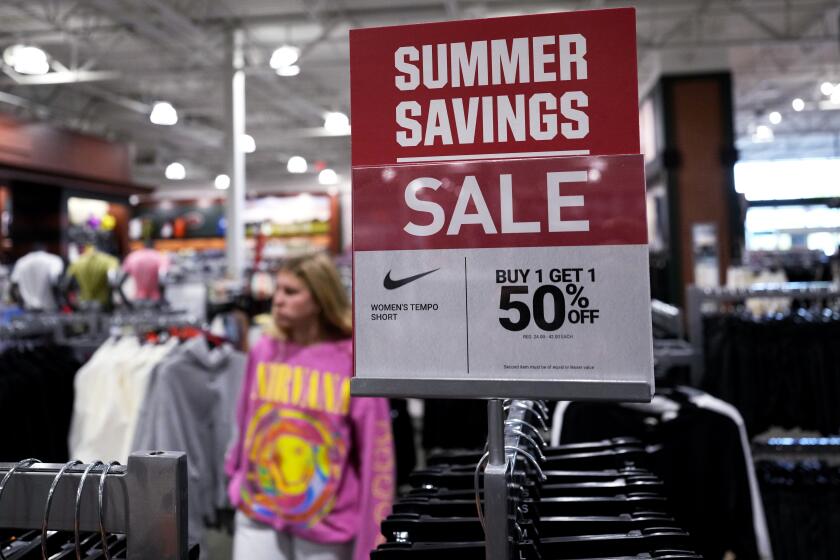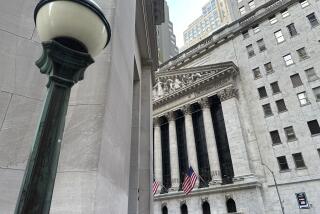Stocks drift after Fed hikes rates as yields fall on hopes that it’s the last one

- Share via
Stocks held steady Wednesday after the Federal Reserve raised interest rates to their highest level in more than two decades, just as Wall Street expected.
The S&P 500 slipped 0.71 of a point, or less than 0.1%, to 4,566.75, remaining near a 15-month high. The Dow Jones industrial average rose 82.05 points, or 0.2%, to 35,520.12, and the Nasdaq composite slipped 17.27 points, or 0.1%, to 14,127.29.
The bond market moved more sharply, and Treasury yields fell after Fed Chair Jerome H. Powell said no decision has been made about whether to raise rates at its next meeting or beyond. That may have bolstered hopes among traders that Wednesday’s hike could be the last for a long time.
Microsoft weighed on the market after falling 3.8%. That was despite reporting stronger profit and revenue for the spring than analysts expected. Analysts said the company made comments that may have been intended to rein in huge expectations for upcoming growth from artificial intelligence. Investors also may have been hoping to hear more about when slowing growth at its Azure cloud computing business will trough.
Microsoft wants to acquire the Santa Monica-based game company behind ‘Call of Duty’ in a $69-billion deal.
Helping to limit the market’s losses was Alphabet, which rose 5.6%. The parent company of Google and YouTube reported better profit and revenue for the spring than analysts expected.
What tech titans do matters more for Wall Street than other stocks because they have become so influential due to their massive size. Seven stocks alone accounted for most of the S&P 500’s returns through the first half of this year, largely on expectations that their explosive growth will continue. They’ll need to deliver big profits to justify those gains.
Another member of the “Magnificent Seven” that have overshadowed the rest of the market reported its results after trading closed for the day, Meta Platforms. The stock has soared 148% for the year so far, while Alphabet and Microsoft are both up more than 40%.
Boeing, meanwhile, was helping to prop up the Dow Jones industrial average, which has less of an emphasis on tech than the S&P 500, Wall Street’s main measure of health. The aircraft maker reported a smaller loss for the spring than analysts expected, and revenue topped expectations. Boeing’s stock rose 8.7%.
In the bond market, the highlight was the Fed’s move to raise its federal funds rate to a range of 5.25% to 5.50% in hopes of wrestling down inflation. That’s its highest level since 2001 and up from virtually zero early last year.
Consumer prices in the United States cooled last month, rising just 0.1% from April to May and extending the past year’s steady easing of inflation.
The hope among traders is that will be the last increase of this cycle because inflation has been on a downward trend since last summer. Such hopes have been another big reason for Wall Street’s big rally this year. That’s because rate increases work to lower inflation by grinding down on the entire economy, raising the risk of a recession and hurting prices for investments.
The economy has so far defied many predictions for a recession, largely because of a remarkably solid job market that has allowed U.S. households to keep spending. That has hopes rising that the Federal Reserve can pull off a rare “soft landing” for the economy during which high inflation falls back to its target without a painful recession.
Some critics, though, say traders may have rushed into such hopes too quickly and too strongly. Inflation is still high, even if it’s come down, and the Fed may need to keep rates high for a while to drive it down to its 2% target. A recession is still a risk, they say.
“The market seems to be talking itself into this internally inconsistent scenario, where growth is OK, inflation is basically solved for and the Fed can start cutting rates,” said Sameer Samana, senior global market strategist at Wells Fargo Investment Institute.
A resilient economy could cause inflation to stay elevated, he said, and inflation could reaccelerate later this year. Prices for oil and other commodities may end the year higher than a year before, for example.
“Unfortunately for the Fed, this is as easy as it gets,” Samana said. “From here, inflation is going to probably prove to be more stubborn.”
The Fed’s Powell said Wednesday that rates will probably need to stay high for a while to drive inflation lower, but he was noncommittal about the possibility of more increases. The Fed’s next opportunity to raise rates will arrive at its meeting in September, and Powell said policymakers want to see more data about where inflation and the job market are heading before then.
“It’s really dependent so much on the data, and we just don’t have it yet,” Powell said.
The yield on the 10-year Treasury fell to 3.86% from 3.89% late Tuesday. It helps set rates for mortgages and other important loans.
The two-year Treasury yield, which moves more on expectations for Fed action, sank to 4.85% from 4.88%. It was above 4.91% before Powell began speaking.
In markets abroad, stocks fell more sharply in Europe. France’s CAC 40 sank 1.4%, and Germany’s DAX lost 0.5%.
In Asia, South Korea’s Kospi fell 1.7% and Japan’s Nikkei 225 was nearly flat. Stocks in China were down modestly as traders wait to see how China’s Communist Party will carry out its promise to shore up sluggish economic growth. The ruling party has pledged to support entrepreneurs and the struggling real estate industry but has given no details.
AP writers Matt Ott and Joe McDonald contributed to this report.
More to Read
Inside the business of entertainment
The Wide Shot brings you news, analysis and insights on everything from streaming wars to production — and what it all means for the future.
You may occasionally receive promotional content from the Los Angeles Times.












